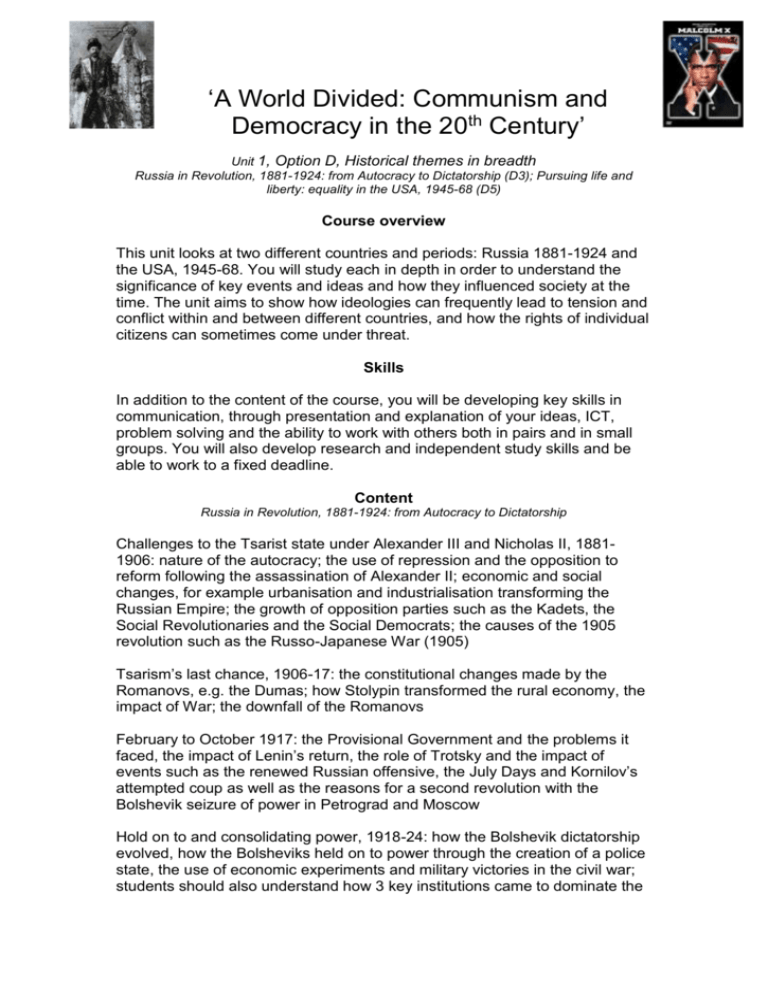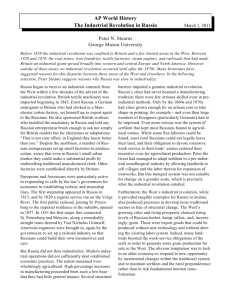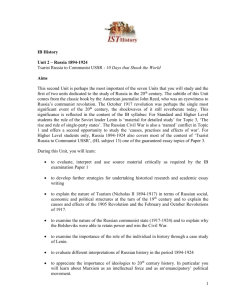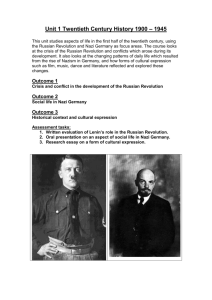A World Divided: Communism and Democracy in the
advertisement

‘A World Divided: Communism and Democracy in the 20th Century’ Unit 1, Option D, Historical themes in breadth Russia in Revolution, 1881-1924: from Autocracy to Dictatorship (D3); Pursuing life and liberty: equality in the USA, 1945-68 (D5) Course overview This unit looks at two different countries and periods: Russia 1881-1924 and the USA, 1945-68. You will study each in depth in order to understand the significance of key events and ideas and how they influenced society at the time. The unit aims to show how ideologies can frequently lead to tension and conflict within and between different countries, and how the rights of individual citizens can sometimes come under threat. Skills In addition to the content of the course, you will be developing key skills in communication, through presentation and explanation of your ideas, ICT, problem solving and the ability to work with others both in pairs and in small groups. You will also develop research and independent study skills and be able to work to a fixed deadline. Content Russia in Revolution, 1881-1924: from Autocracy to Dictatorship Challenges to the Tsarist state under Alexander III and Nicholas II, 18811906: nature of the autocracy; the use of repression and the opposition to reform following the assassination of Alexander II; economic and social changes, for example urbanisation and industrialisation transforming the Russian Empire; the growth of opposition parties such as the Kadets, the Social Revolutionaries and the Social Democrats; the causes of the 1905 revolution such as the Russo-Japanese War (1905) Tsarism’s last chance, 1906-17: the constitutional changes made by the Romanovs, e.g. the Dumas; how Stolypin transformed the rural economy, the impact of War; the downfall of the Romanovs February to October 1917: the Provisional Government and the problems it faced, the impact of Lenin’s return, the role of Trotsky and the impact of events such as the renewed Russian offensive, the July Days and Kornilov’s attempted coup as well as the reasons for a second revolution with the Bolshevik seizure of power in Petrograd and Moscow Hold on to and consolidating power, 1918-24: how the Bolshevik dictatorship evolved, how the Bolsheviks held on to power through the creation of a police state, the use of economic experiments and military victories in the civil war; students should also understand how 3 key institutions came to dominate the country – the Party, the Red Army and the secret policy in the creation of the Soviet state Pursuing life and liberty: equality in the USA, 1945-68 The social and economic position of Black citizens in different parts of the USA in the 1940s; the impact of WWII on improving opportunities for advancement, internal migration and the beginnings of reform; students should be aware of the work of the NAACP and understand the importance of the constitutional case of Brown v. Board of Education (1954-5) the nature and extent of discrimination and segregation; signs of change by 1955 Martin Luther King and peaceful protest: the forces opposed to equal rights and the ways this was expressed; the aims methods and effectiveness of the civil rights movement; the key features of the Civil Rights Acts (1957, 1960, 1964, 1965 and 1968) to be aware of the impact of the campaigns and the role of Federal government Black power and the use of violence; the extent to which equality had been achieved by 1968, with some reference to the roots of the movement; students will study the divisions that arose between leaders of the civil rights movement over the use of peaceful protest or violence; the impact of conflicts like Vietnam on the movement The changing economic and social environment of the 1960s: the position of other ethnic minorities such as Native Indians or Hispanic immigration; the protest culture associated with Vietnam, women’s liberation and individual freedom Assessment This unit counts for 50% of the total AS marks and 25% of the total A Level marks. Your results at AS will be graded from A-E, but the full A level will be graded from A* to E. You will find out how you performed individual units should you wish to retake. The grade boundaries for unit 1 are as follows: Unit grade A B C D E Percentage 80 70 60 50 40 Please note that quality of written work (SPAG) will count towards the overall grade. You will have a choice of one out of two questions in each topic studied. You must answer one from each topic. Each question is worth 30 marks. Example questions include ‘How far is it accurate to describe ...?’, ‘How extensive was opposition to …?’, ‘How far did … improve?’, ‘How important was … in increasing opposition / support?’, ‘How important was the contribution of …. To the development of …?’ You will have 1 hour and 20 minutes. Sample questions Russia How far was the First World War the main cause of the fall of the Romanovs in February 1917? How far do you agree that the Bolsheviks won the Civil War of 1918-21 because they controlled more people and had more access to weapons? USA How far is it accurate to describe black Americans as second class citizens in the years 1945-55? How far is it accurate to say that the Black Power movements of the 1960s achieved nothing for black Americans? Bibliography www.edexcel.org.uk is the website for the Exam board offering this A Level. On the home page you’ll find links to useful pages such as the Examzone, exam specifications and guidance on further resources and study materials. Russia Introductory reading: Figes, Orlando, ‘A People’s Tragedy: Russian Revolution, 1891-1924’ (1997) Oxley, P, ‘Russia 1855-1991: from Tsars to Commissars’ (2001) Reed, J, ‘Ten Days that Shook the World’ (New edition, 2007) Service R — Lenin: A Biography (Pan Books, 2002) Warnes, D, ‘Chronicle of the Russian Tsars: the Reign-by-reign record of the Rulers of Imperial Russia’ (1999) Exam board recommended texts Culpin C and Henig R — Modern Europe 1870-1945 (Chapter 6) (Longman, 1997) Daborn J — Russia: Revolution and Counter Revolution, 1917–1924 (Cambridge University Press, 1991) Darby G — The Russian Revolution: Tsarism to Bolshevism 1861–1924 (Longman ‘History in Depth’ series, 1998) Evans D and Jenkins J —Years of: Russia and the USSR 1851–1991 (Hodder and Stoughton, 2001) Farmer A — An Introduction to Modern European History 1890–1990 (Hodder and Stoughton ‘Access to History Context’ series, 2000) Hite J — Tsarist Russia, 1810–1917 (Causeway Press, 2004) Laver J —Lenin: Liberator or Oppressor? (Hodder and Stoughton ‘Personalities and Powers’ series, 1994) Lynch M — Reaction and Revolutions: Russia 1881–1924 (Hodder and Stoughton ‘Access to History’ series, 1992) Lynch M — Trotsky: The Permanent Revolutionary (Hodder and Stoughton ‘Personalities and Powers’ series, 1995) Murphy D and Morris T — Europe 1870–1991 (Collins Educational, 2004) Phillips S — Lenin and the Russian Revolution (Heinemann ‘Heinemann Advanced History’ series, 2000) Service R — Lenin: A Biography (Pan Books, 2002) Traynor J — Europe 1890–1990 (Chapter 4) (Nelson Thornes, 1991) White A — Lenin’s Russia (Collins, 1998) USA Introductory reading: Brogan H — The Penguin History of the USA 2nd edition (Penguin. 2001) Fairclough A — Martin Luther King (University of Georgia Press, 1995) Exam board recommended texts: Dinnerstein L — Natives and Strangers: Blacks, Indians and Immigrants in America (Oxford University Press, 1990) Farmer A and Sanders V — An Introduction to American History, 1860–1990 (Hodder Murray, 2002) Jones M A — The Limits of Liberty, 2nd edition (OUP, 1995) Mooney P J and Bown C — Truman to Carter: A Post-War History of the United States of America (Edward Arnold, 1979) Riches W — The Civil Rights Movement: Struggle and Resistance (Macmillan, 1997) Sanders V — Race Relations in the USA since 1900 (Hodder and Stoughton, March 2000) Paterson D, Willoughby D and Willoughby S — Civil Rights in the USA 18631980 (Heinemann, 2001) Weblinks There are a host of weblinks dedicated to both Russian and US history and your teacher will give you a list of these at the start of the course. Sites with a good range of articles and information to begin you research include: http://www.spartacus.schoolnet.co.uk/ http://www.historylearningsite.co.uk/ http://www.bbc.co.uk/history/ Films & literature To give you a sense of the period and some of the key events it is worth taking a look at some of the books and films which cover the period. For Russia the classic ‘Dr Zhivago’ will provide fascinating insights into the Civil War (1918-21) and for America have a look at the film ‘Malcolm X’ as well as ‘Mississippi Burning’ which look at the role of black power and the use of violence by white supremacist groups like the KKK respectively.









